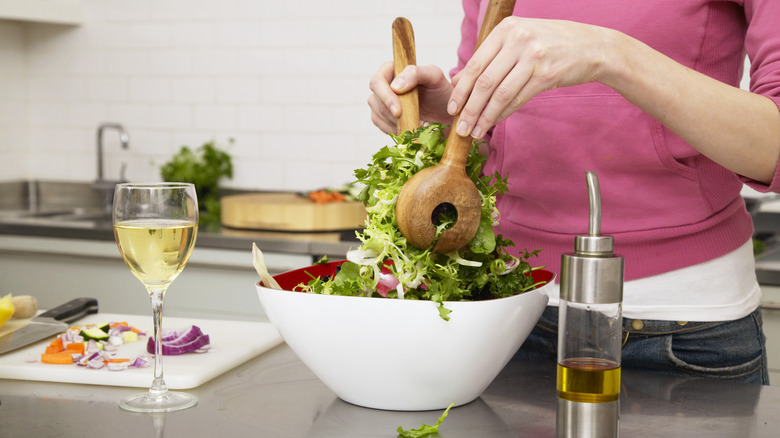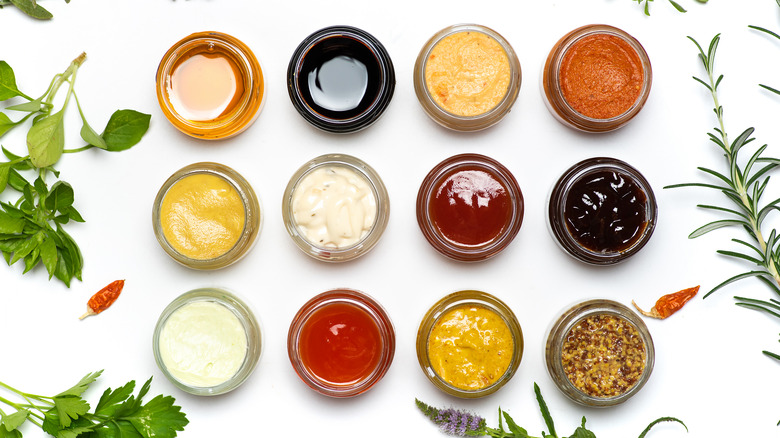Why It's Difficult To Pair Salads And Wine
If you've ever taken a bite of salad and then a sip of wine, and wondered why your wine tastes flat, almost like water, you're not alone. Matching a wine with a flavorful salad can be tricky. For one, there are perhaps just as many kinds of salads as there are wines in the world. The choices can be overwhelming. And second, you might be pairing your wine with the wrong components in your leafy meal.
In a salad, there are a lot of components to consider: veggies, fruit, protein, cheese, and dressing. Maybe there are beans and croutons or a hearty serving of quinoa. But the trick is not to get confused by all these components when picking a wine. Instead, focus on pairing the wine with the dressing.
Salad dressing sets the stage for the overall flavor of the meal. Whether it's a sweet dressing or a zesty one, pairing wine with this single component can make life a whole lot easier. There are simple ways to match salads with wine, beginning with the level of acidity.
Acidity loves higher acidity
Acidity is what makes our mouth pucker and salivate. It's that tongue-popping tartness that is super refreshing in food. Geek break: We salivate after eating or drinking something sour because our body is trying to regulate the pH balance in our mouths by washing away the high acidity.
Most salad dressings are pretty acidic and as a result, need to be paired with a wine with an even higher acidity. That's because when you take a bite of acidic salad, your palate becomes used to that level of tartness. If the wine has a lower acidity, your palate will not be able to detect it, making the wine taste flabby and flat. Paired with a high-acid wine, on the other hand, your wine will show more fruitiness, along with balanced acidity.
Light, high-acid white wines like Sauvignon Blanc, Kabinett Riesling, and Vinho Verde will work well with most salads. The grassy green notes in Sauvignon Blanc are especially delicious with romaine lettuce. Sparkling wines and rosés also have high acidity and fruit character and are safe bets.
Fill in the blanks in your dressing
Another way to pair wine with salad is to consider if your dressing is missing a flavor. You can fill it in with the key flavor in the wine. For example, the dressing in a Caesar salad is fatty and uses anchovies for savory flavors. Pairing it with a light body Sauvignon Blanc, which has high acidity, will offer a bright sour note that was missing in the dressing. The wine fills in the missing flavor.
Similarly, a spicy ginger sesame dressing will pair brilliantly with a lightly sweet wine like an off-dry Riesling or Vouvray. The light sugar in the wine will add fresh fruitiness to the savory salad and balance any ginger spice. A bleu cheese dressing is delicious with an Albariño, known for its zippy acidity, slight salinity, and citrus and melon flavors. A balsamic vinaigrette salad will work well with a light Pinot Noir. Think of your wine as the dressing, too. Would it work poured on your salad? Then it will work paired with it.
So, start simple and try different combos. Ask the sommelier or server at a restaurant for their recommendation and be sure to ask why they are recommending the wine with your salad. Now that you've got the chops, you can say things like "high acidity" and "fruity melon flavors" when discussing the wine.


